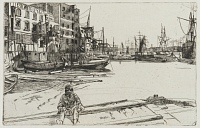Eagle Wharf | ||
| Number: | 50 | |
| Date: | 1859 | |
| Medium: | etching | |
| Size: | 140 x 217 mm | |
| Signed: | 'Whistler.' below centre | |
| Inscribed: | '1859.' at lower centre | |
| Set/Publication: | 'Thames Set', 1871 | |
| No. of States: | 1 | |
| Known impressions: | 73 | |
| Catalogues: | K.41; M.40; T.40; W.39 | |
| Impressions taken from this plate (73) | ||
TECHNIQUE
This is pure etching, with no drypoint.
PRINTING
Over seventy impressions have been located plus three from the cancelled plate. About 1862, Whistler recorded either the number of impressions printed, or more likely the number of impressions of some etchings in stock: 'Limehouse 10.
/ Tunnel pier 2. / Black Lion 8.
/ Graveur - 2
/ Thames Police. 20 / Tyzack 5' 19
19: [May 1862/1864?], GUW #12745, p. 38.
It is likely that the impressions acquired by Francis Seymour Haden, Sr (1818-1910) were among the earliest printed. They were printed in black ink; papers include a light green or blue 'antique' (pre-1800) laid paper now faded to off-white with 'I Honig Zoonen' watermark, (). A similar medium-weight greenish off-white laid paper was used for another impression acquired by Philippe Burty (1830-1890), possibly in Paris (). Another impression owned by Haden is on buff 'antique' laid with a lion watermark ().
Other early impressions include one given - or at least inscribed - to George Aloysius Lucas (1824-1909), which is on pale tan 'antique' laid (); one inscribed 'Early proof - 1st state' on pale grey oatmeal-texture wove paper (); and one on a bluish off-white laid paper ().
A significant number of impressions are on Asian paper. An early impression signed by Whistler is on a buff Asian rag paper with grey fibres (): others are on thin cream Japanese tissue (); cream or ivory Japanese (, ); cream Asian laid (, , ); and ivory Japanese laid paper (, ).
In addition many published by Ellis & Green in 1871 are on watermarked laid paper, including 'DEDB' and beehive watermarks (, , ) and 'DE ERVEN DE BLAUW' (, , ). Other watermarked sheets include ivory paper with partial 'HUDELIST' watermark (; and cream 'modern' paper with a circular watermark ().
Other papers include ivory laid paper removed from a book, which was used for two impressions (, ); paper removed from a ledger with blue edges (); a dark cream uneven and soiled sheet of 'antique' laid paper from a book (); and soiled ivory laid paper (). Sometimes, but rarely, it was printed on wove paper ().
A late impression, possibly from the edition printed by Frederick Keppel (1845-1912), is on a white laid paper (). Cancelled impressions are on cream or ivory wove paper (, , ).
